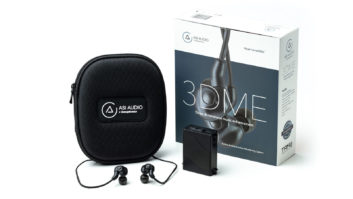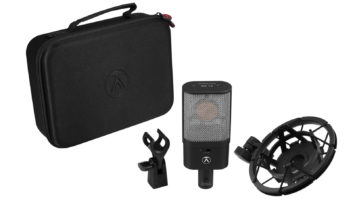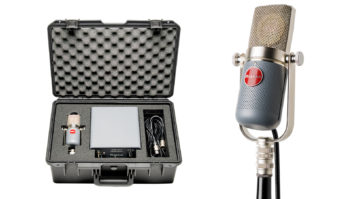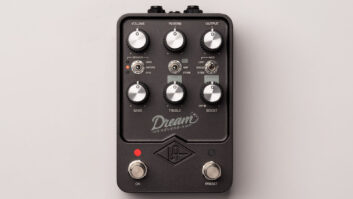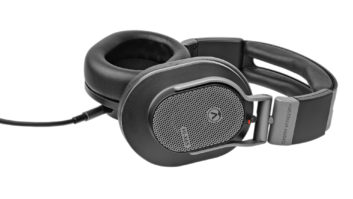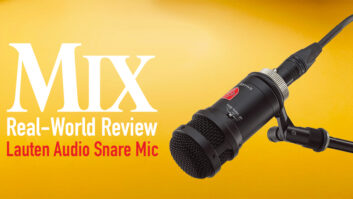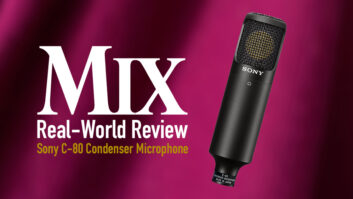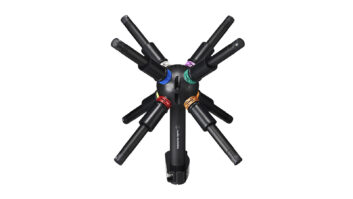Microphone manufacturer Sterling Audio has a new addition to their line, the lovely-looking ST6050: a large diaphragm, Class-A, FET-type condenser, voiced by two-time Grammy winner Allen Sides, founder and owner of the legendary Los Angeles recording facility, Ocean Way Studios. Chinese manufacturing allows a street price of $999, so the natural question is just how good can this genteel, yet affordable microphone sound?
Features
The cardioid-only ST6050 uses a 1-inch x 8 micron gold-sputtered diaphragm, a FET preamp and an output transformer with “side by side” windings that reportedly yield “even low frequency response while maintaining openness and top-end air,” according to Sterling Audio. The ST6050 has a brass body, chrome-plated brass headbasket and chrome-plated closing ring. A wooden storage box, windscreen and Sterling Audio’s SM7 full-spider suspension shockmount are included. The ST6050 has an impedance of 200 ohms, 134 dB SPL max (no pad) and 17 dB of self-noise (A-weighted) with an MSRP of $1,695 (but regularly sells for $999 via Sterling Audio’s parent company, Guitar Center, outside sales team GC Pro, and its internet/mail order retail division, Musician’s Friend). Sterling Audio provided me with an ST6050 pair for this full evaluation.
In Use
I commenced testing with some acoustic guitar tracking, a very insightful way to get to know a new microphone, in my experience. My initial reaction was that the ST6050 is largely neutral, in that it was not imparting a burst of color or a swath of personality on the sound source. In this application, bottom end was rather solid and in just the right amount; not peaky (or scooped); low-mids were strong with ample body and no hollowness; true mids didn’t grab my attention at all; and the top end was noticeably bright, but not as bright as many budget or similarly-sourced LDCs. Transients and dynamics were natural and unforced. With a ST6050 spaced pair (one near bridge, one near neck) I received an acoustic sound that required very little EQ, which was rather pleasant in its simplicity.
On pedal steel guitar, I put up an SM57, which alone was a little harsh, with an ST6050 alongside it to fill out low-mids and round out the bottom end; it did exactly that, all without adding too much top. What seemed too bright at first worked well in my mix with some compression/limiting and no EQ.
Now more encouraged, I tried the ST6050 for electric guitar overdubs and got mostly good, yet mixed, results. Clean and “brown” sounds were A-OK with warm musicality, workable proximity effect, excellent low-end texture and just the right amount of sharp definition, but high gain sounds and solos got a little brittle and piercing for my tastes.
Then over the next two weeks, I had a long run of vocal tracking (of every type imaginable) where I put these ST6050s to work. Bottom line: the ST6050 is quite capable of finely capturing vocals of all types, as its inherent midrange neutrality conforms to the source without drawing attention to it. The ST6050’s transformer and thick diaphragm do their jobs well, indeed, as the bottom end on vocals is properly full (especially with some proximity), but balanced by a dash of hype at 10 kHz. In fact, the ST6050’s frequency response graph shows 6 dB of boost around 9-10 kHz (!); it didn’t sound like that much and I found that rotating the vocalist a little off-axis helps to tame the brightness when itistoo much.
Next, I hit up my Charlotte-based colleagues at Concentrix Music and Sound Design (concentrixmusic.com) for some additional testing and, fortunately, they had a horn session booked with two mics queued up (a Royer R-121 and a vintage Neumann U47 tube, modified by Blue) to shoot out alongside the ST6050. On flute, the ST6050 was simply too bright, so the Concentrix guys went with the U47. On soprano sax, they felt the ST6050 was too honky (much to my surprise), thus they went with the Royer ribbon. Yet on tenor sax, the porridge was finally just right, as they enthusiastically selected the ST6050, no EQ at all in the crisp, modern jazz mix.
My own favorite job for the ST6050 was using the pair on drum overheads. You’ll be hard pressed to get a pair of these big blue beauties close to coincident without a couple of heavy duty stands and patience, but in aspacedpair, they sound really good: no overload issues, excellent dynamics and great imaging (generally an indicator of good consistency/matching), acting as if they are “pre-EQed” with some exciting sizzle up top and a big, fat, extended, kick-drum-all-up-in-it bottom end. Sure, maybe hi-hat became just a little rude, but considering the phat toms and great low end extension, high-pass filter a bit to taste, and enjoy.
For the benefit of our readership, I had pianist Chris Pittman lay down a simple melody twice via ST6050 pair: once to record in X/Y and again as a spaced pair (audioclips #1 and #2, respectively). With the unprocessed, “raw” 96 kHz audioclips (aided by an Earthworks 1024 ultra-low distortion preamp), you’ll notice a bit of 350 Hz boxiness (as is typical for my piano/room), but also a substantial bottom end that translates the sustain pedal’s thump (all too well), largely honest mids, natural transients and a little extra clarifying high-end hype.
Summary
I’ve completed all this work with the ST6050 pair, and yet I still have not formed an exact opinion of them. They’re aesthetically beautiful, sonically (mostly) neutral, and with that substantial 9 kHz bump (which only sometimes gets in the way), it’s easy to find them useful. Then again, they never exactly jumped out at me to scream of their perfection on any one application, though they did impressively well on drums and most vocals.
I may not be alone in my trouble reaching a decisive conclusion, as I’ve found the world wide web bristling with typically-cynical curiosity about the ST6050’s composition. Some express skepticism about whether the 6050’s construction is up to par for the price, and/or if it uses the same KT77 capsule/components once found in Sterling Audio’s starkly similar ST77. Thus I have disassembled a 6050 for your perusal, pictured within this review. To my eyes, the body appears to be steel rather than brass (not to mention that the body is a little thinner than those of comparable Chinese-built LDCs in my own locker), yet the ST6050 did not offer excessive resonance problems in my use. Its construction looks standard, workmanship is consistent throughout and resistors are 1% tolerance, although solder joints were more sloppy than I’d prefer. So, is the ST6050 capsule the KT77 from the ST77 (a discontinued model, MSRP $999/MAP $499)? With no ST77 to directly compare with the ST6050, I’m respectfully bowing out on that one.
Alan Sides is currently using the ST6050 on a variety of upcoming releases. Demo tracks of the ST6050 recorded by Sides at Ocean Way are available for download at www.sterlingaudio.net. I would encourage you to audition those files and form your own opinion.
And I will say this: even if the ST6050 isn’t my personal “go-to” mic for any one application, it is a simple, straight-forward LDC that works well at most everything and excels on ambient drums and vocals with a few limitations. It would be a fine choice for the studio seeking its first killer microphone, one that would carry a lot of that studio’s tracking workload due to its flexibility and versatility.
Rob Tavaglione has owned and operated Catalyst Recording in Charlotte NC since 1995. rob(at)catalystrecording.com
Price: $999 street
Contact: Sterling Audio | sterlingaudio.net
